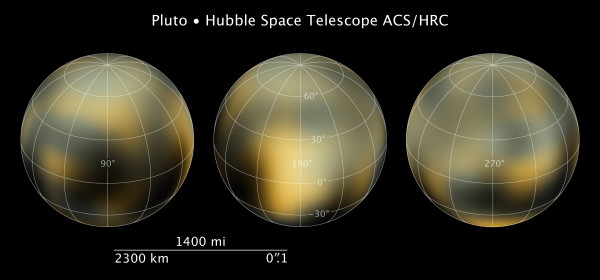New Maps of Pluto Show Seasonal Changes

NASA has released new maps of Pluto, taken by the Hubble Space Telescope’s Advanced Camera for Surveys. Even through the Hubble, everyone’s favourite Kuiper Belt Object is only a handful of pixels across, and the Hubble can only make out surface variations a few hundred kilometres in size. Even so, this is probably the most detail we’ll get until New Horizons arrives in five years’ time. And it’s still of use to scientists:
The images taken by NASA’s Hubble Space Telescope show an icy and dark molasses-colored, mottled world that is undergoing seasonal changes in its surface color and brightness. Pluto has become significantly redder, while its illuminated northern hemisphere is getting brighter. These changes are most likely consequences of surface ices sublimating on the sunlit pole and then refreezing on the other pole as the dwarf planet heads into the next phase of its 248-year-long seasonal cycle. The dramatic change in color apparently took place in a two-year period, from 2000 to 2002. …
Hubble reveals a complex-looking and variegated world with white, dark-orange and charcoal-black terrain. The overall color is believed to be a result of ultraviolet radiation from the distant sun breaking up methane that is present on Pluto’s surface, leaving behind a dark and red carbon-rich residue.
More from Bad Astronomy. Emily Lakdawalla has created a video of a rotating Pluto from the still images. Image credit: NASA, ESA, and M. Buie (Southwest Research Institute).
Previously: Map of Pluto.

Comments
blog comments powered by Disqus